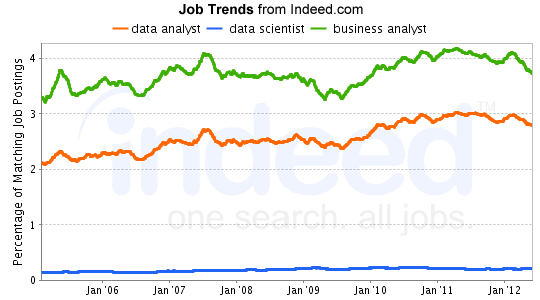Analytics
News, events, thought leadership and more.- Subscribe to RSS Feed
- Mark as New
- Mark as Read
- Bookmark
- Subscribe
- Printer Friendly Page
- Notify Moderator
Data Analysts, Data Artisans and Business Analysts are being done a disservice by some of the ink given to Data Scientists in the Big Data Analytics space lately. Clearly the market for the emerging role of Data Scientists is extremely hot: the skills required for this role are rare, but also very valuable and thus the people that have such skills (e.g. PhD in Statistics, Math or Computer Science) are in tremendous demand.
But that doesn't mean that Analysts are not still in high demand also … and it doesn't mean we should downplay or redefine the Data Analyst role to be narrower in order to over-emphasize the scope of problems that require a Data Scientist to solve. Rather, we should continue to provide business analytics tools and training that help to evolve Data Analyst's Big Data skills and access - an idea we have been promoting at Alteryx for some time in the context of the Data Artisan concept and the capabilities our product delivers for Big Data Analytics.
So with that I wanted to correct two points made in an otherwise very insightful article from earlier this week called "Data Scientist: Hot Big Data Job" by InformationWeek. First, the sub headline of the article ("These specialists, who can supervise the integration of many types of data, find themselves in great demand compared to traditional data analysts") was misleading in that it made it seem like there is currently more demand for hiring Data Scientists than for Analysts. I don't think that's true. The demand for Data Scientists is growing at a faster rate, but there are still more Data Analysts positions in the business world and by quite a stretch - the trick is that these roles have less title standardization, and instead go by several different names including Business Analyst, Data Analyst, Customer Analyst, Revenue Analyst, GIS Analyst, Manager of Market Planning, Strategic Planner, Data Artisan and more (sometimes Financial Analyst or Risk Analysts also apply here though those titles can be used in different ways too). But cumulatively there are definitely more positions as well as more people in this category verses the Data Scientist category. For example, here is the chart from Indeed.com that just looks across the big three mentioned above (Data Analyst, Data Scientist, Business Analyst):

Also relevant to this discussion is some research we worked with the Economist Intelligence Unit on this month which found that 77% of business leaders believe more employees need access to Big Data in order to make more informed decisions (as compared to those who currently have access). The findings of this research, which reinforces the fact that most business executives want to increase access, tools and skills for more line of business employees rather than keep control in the hands of the very few, will be featured in a September report on "Democratizing Big Data Decisions" by the Economist Intelligence Unit and will be previewed in our upcoming August 30th Alteryx Webinar on Big Data Analytics and the Big Data Decision Gap with Michael Singer ....
The second issue with the InformationWeek article was that, probably in an effort to simplify the differences in the relevant roles, it tried to position data analysts as married to a single source of data. A section in the middle of the article reads "Traditional data analysts look at data from a single source... Data scientists examine data from multiple sources, rationalize differences among the data types, and create a data set usable by less specialized analysts …according to IBM." However, the first part of that sentence, "Traditional data analysts look at data from a single source" is not true. In fact, we at Alteryx see many of the data analysts at our customers doing more of the things attributed to Data Scientists in the above quote than looking only at data from a single source. The data analysts we work with, in fact thrive on the ability to look at combinations of data across spreadsheets and other files, data warehouses, various sources of Big Data (whether it's a social media stream or data stored in Hadoop or MongoDB), and packaged market data (e.g. Dun & Bradstreet firmographics, Experian household and segmentation data, US Census demographic data, and TomTom spatial data). Not only will the forthcoming Economist Intelligence Unit report reinforce the need for data analysts and business users to combine Big Data with many other traditional data sources and types, but Alteryx currently has a lot of real world Data Analysts (or Data Artisans) who already combine lots of different data sources and types to achieve Strategic Analytics, some of which are featured in the videos below:
Bill Abt of The Yankee Candle Co.
- Zakir Syed of Walmart
- Michael Healy of Bloomin' Brands (formerly OSI Restaurants)
- Kara Mills of American Dairy Queen
So while we are all excited about the emergence of the "Data Scientist" role and agree on how valuable that skillset can be in the broader Big Data Analytics ecosystem, we shouldn't underrepresent how important Data Analysts are, how much different data they frequently analyze in combinations, and how much demand there is for them in the business analytics space.
Rick Schultz
SVP, Marketing
You must be a registered user to add a comment. If you've already registered, sign in. Otherwise, register and sign in.

